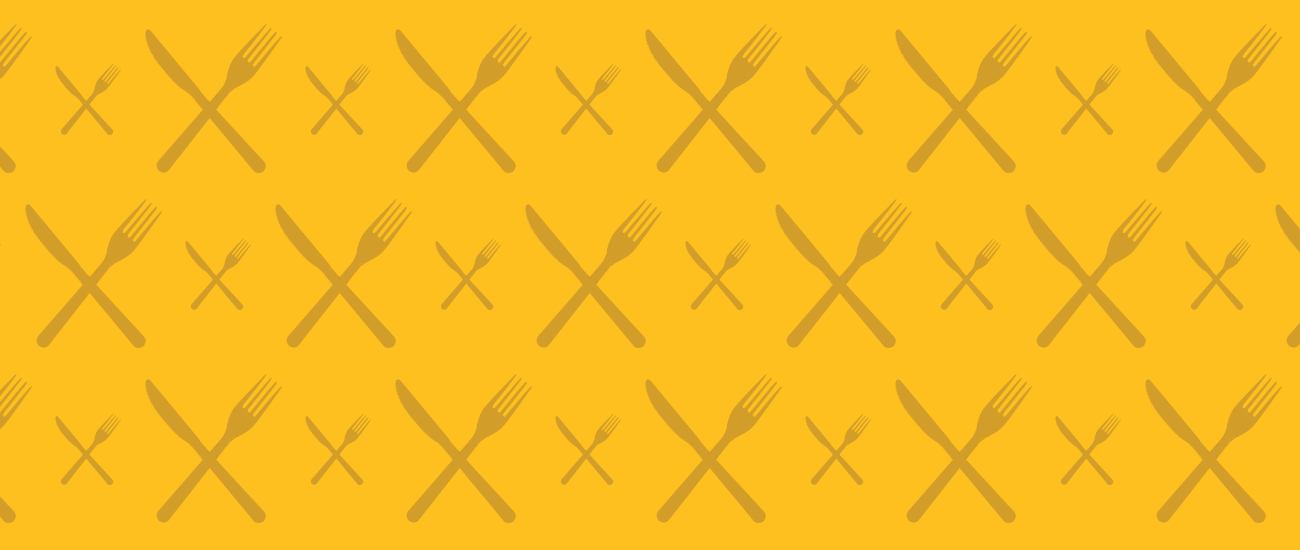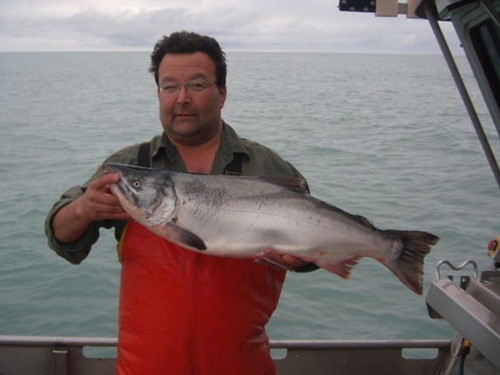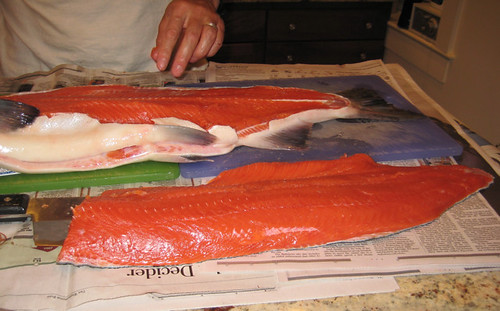Washington SeaSA, my little venture buying sustainable seafood direct from fishermen for a group of about 10 families in DC, is now in year two. Latest on the menu: sockeye salmon from Bill Webber, who fishes the flats off the Copper River in Alaska. This followed an oyster shucking party, with the farm-raised bivalves from Rappahannock Oyster Co. They were excellent.
I first met Bill last year, when I made the trek up to Alaska to see the fishery. It didn't take me long to ask Bill if he'd ship direct to us and he said he would, as long as we met his 50 pound minimum. Which is why I corralled up my friends. It wasn't a hard sell.
Bill sends us whole fish, headed and gutted. He also bleeds the fish on his boat, which he argues makes for a much fresher fish. Blood begins to decay once the fish dies and that in turn degrades the flesh, so if you remove the blood -- with a special pressure tube he developed -- you can slow down the clock. He then ships the fish to us in a chilled pack and I drive out to Alaska Airlines' cargo dock to pick it up.
Now, when you buy salmon in the store, you only get the fillet. Getting the whole fish is a different story. I fillet the salmon on our kitchen counter (with an excellent sashimi knife I got from Japan). Aside from the fillet, I'm left with the rich belly meat, which is the bacon of salmon and is excellent fried in a pan. (What can I say, pork belly, salmon belly, it's all good). Then there's the carcass which usually has about a pound of meat on it. These "waste products" amount to a lot of food.
So what do you do them?
With our last fish, I made stock, layering sliced onions and thin fennel stalks and drizzling them with olive oil. Then I placed the 2-1/2 pound liberally salted carcass on top, covering and then sweating the fish on a low flame for 20 minutes. I then added water and a cup of dry white wine to cover, simmering it for another 20 minutes. Finally, I took it off the heat and let the fish sit for an hour to release its essence. This follows Rick Moonen's method in Fish Without a Doubt: The Cook's Essential Companion
Once the stock cooled, I strained it, and then removed the meat from the bones, ending up with a big container of salmon delicately flavored by the fennel. I ate salmon salad sandwiches for several days, though you could also make salmon croquettes, as another friend did with the remnants of her stock.
Since we had eaten our fill of fresh salmon over a couple of days, I took a remaining fillet and cut thin paillards -- angled cuts 1/4 inch thick -- a wonderful technique I also got from Moonen's book. I salted them, wrapped them up in plastic wrap and froze them (a typical Japanese home-cooking method). These can be taken out and cooked immediately in a toaster oven or in a broiler. They cook in about 4-5 minutes if frozen, or about a minute on each side if defrosted or fresh. So it's a really fast dinner.
With the stock on hand, I was thinking paella but was short a few ingredients. I went ahead anyway since I wanted to use the stock.
I sauteed a fennel bulb, an onion, half a red pepper, 2 slices of bacon, a clove of chopped garlic and an Italian sausage I had laying around. When the veggies were soft and the meat brown, I added just over a cup of arborio rice and sauteed it for a minute. Then I poured in a cup of simmering stock, with a generous pinch of saffron, stirring now and then. As the stock was absorbed by the rice, I added more. What I wouldn't have done for a dozen mussels or clams!
Halfway through, I oiled up three of the frozen paillards and put them in the broiler. They sizzled while the paella continued to cook in the stock.
With everything nearly done, I sauteed a bunch of rainbow chard and garlic from the garden and out came the dinner -- a thoroughly satisfying plate of pseudo-paella, broiled salmon and sauteed chard.
Using the whole fish is a bit of work, or rather it takes time to prepare. But once you have the fish, you realize all the possibilities at hand. Now, if I could just get salmon roe in Bill's next shipment.
Addendum: Here's another tip. Fire up your grill. Cut the stalks off a fennel bulb. Rub a fillet with olive oil and season it with salt . When the fire has burned down to medium heat, lay the stalks over the grill and lay the fish on top. You'll have fennel perfumed salmon. The salmon should flake when done, but still be visibly moist inside. Remove from the fennel, then drizzle more olive oil, lemon and/or fresh oregano on the fish and serve.
- Samuel Fromartz



